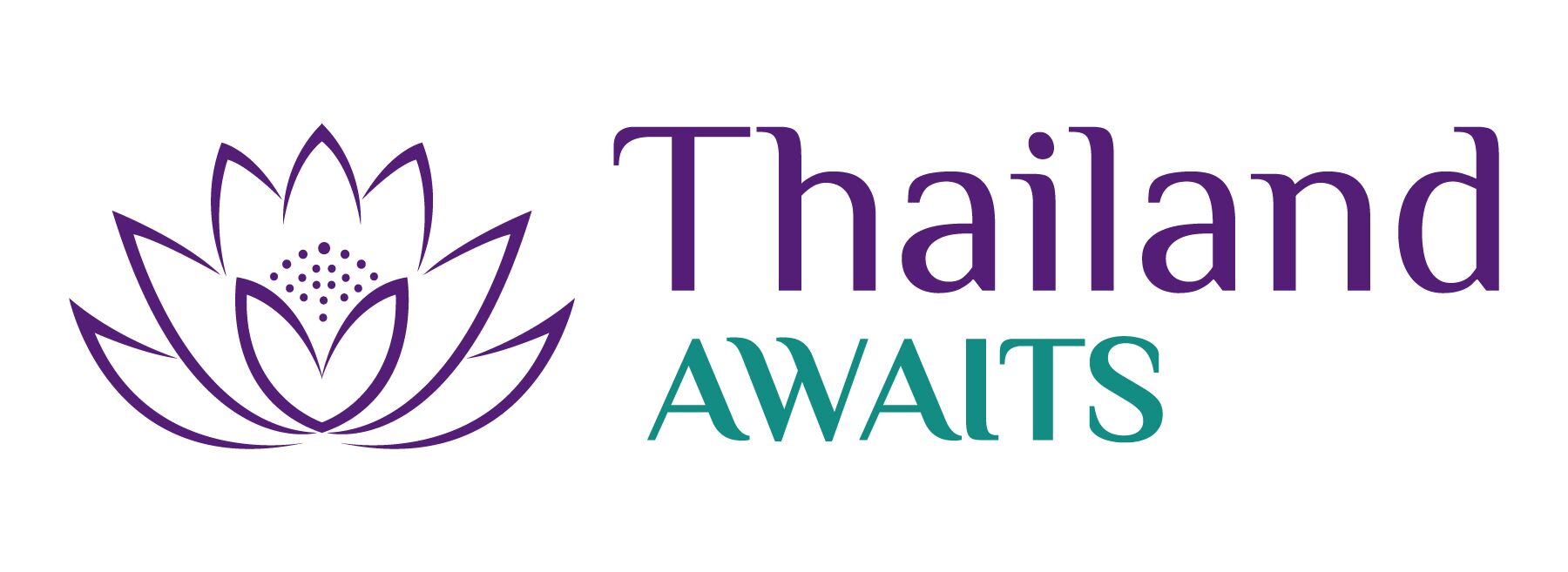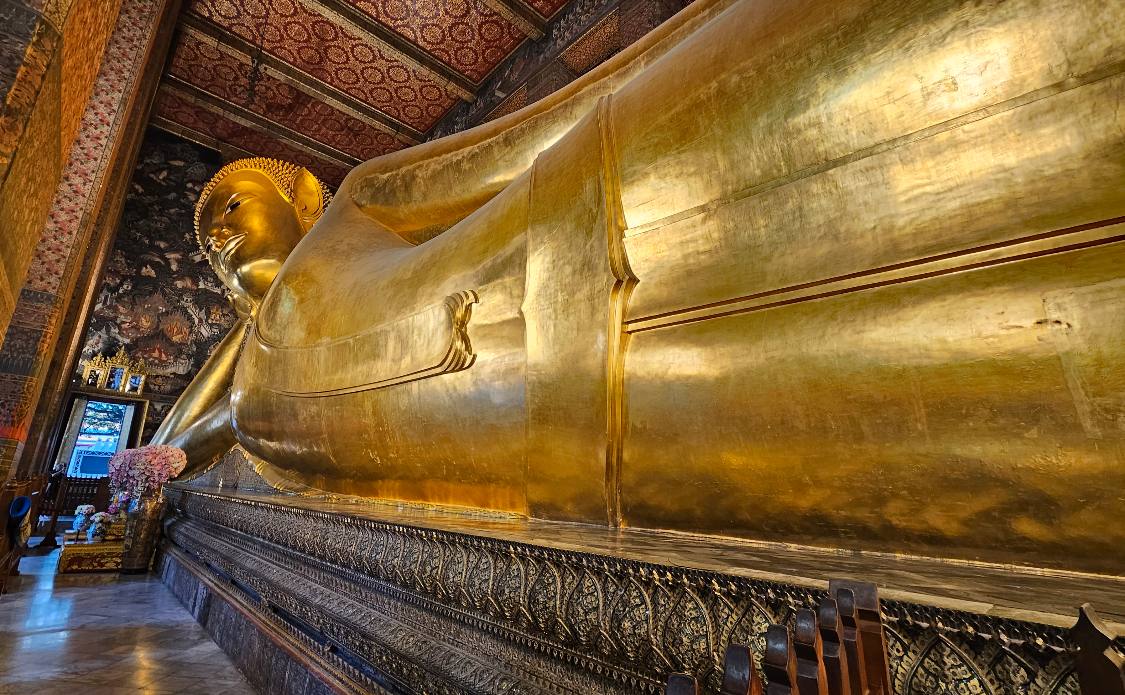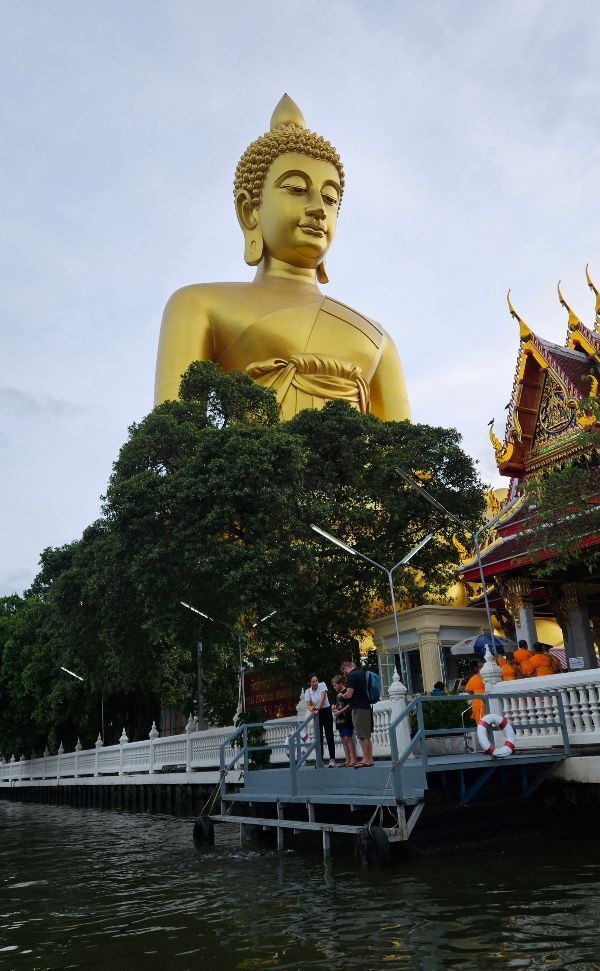We’ve created this easy-to-follow Bangkok temple tour to help you when you plan your visit to some of the city’s important temples. During our first trip to Bangkok, we found it challenging to manage our itinerary. We were unfamiliar with the city, and it all seemed rather overwhelming.
We hope with the help of our tips below, you’re able to merge temple tours with visits to nearby sites and some of our favourite places to eat. This will result in a fun, thoughtfully paced day of exploration rather than a frantic race from one temple to another.
This page contains affiliate links. Please see our disclosure policy for more details.
Below we have shared five of our favourite Bangkok temples. From our first visit in the 1990s, we have now spent several months in Bangkok and have visited the first four temples listed several times. The final one is a recent addition and well worth the little extra effort it takes to visit.
What is the best way to see Bangkok’s temples?
You can try to see the most famous temples in Bangkok in one day on a guided tour, but honestly, this would not be my first choice.
When we first arrived in Bangkok, we tried to cram as many temple visits as possible into a single day. It didn’t go well. We were exhausted, overheated, and all the temples started blending together. Trust me, “Temple Fatigue” is very real.
Instead of rushing from one temple to another, take it slow. Here’s a more enjoyable approach:
- Pick Your Favorites: If you’re short on time, choose two or three temples that intrigue you the most. For example, start with an iconic one like Wat Pho and then explore a lesser-known gem like Wat Saket.
- Space Out Your Visits: If you’re in Bangkok for several days, space your temple visits out. Aim for one or two temples a day. This slower pace allows you to truly appreciate the intricacies of each site without feeling overwhelmed.
- Mix and Match: Combine a well-known temple with a newer or less-visited one. For instance, pairing the majestic Wat Arun with the serene Wat Paknam Phasi Charoen offers a balanced experience of Bangkok’s rich temple culture. This way, you can enjoy popular highlights and savor quieter moments.
Also plan your day with some breaks. After a temple visit, cool off with a meal at a local restaurant or visit an air-conditioned museum. This gives you a chance to relax and reflect without feeling rushed.
Remember, the goal is to take in the beauty and peace of these sacred places, not to check off a list. Enjoy the journey, not just the destination.
Which are the must-see temples in Bangkok?
My must-sees may not be yours; however if this is your first visit, then I would choose Wat Pho and its reclining Buddha.
If time is short, you can enjoy the iconic Wat Arun on the riverside from a distance. It looks especially beautiful at night.
For something entirely different, take a trip to Wat Paknam Phasi Charoen, preferably by long-tail at sunset.
Wat Pho: The Temple of the Reclining Buddha
Wat Pho is one of the most famous and oldest temples in Bangkok. It’s best known for its massive reclining Buddha statue, which is 46 meters long and covered in gold leaf. However, what most visitors don’t realise is that Wat Pho has a lot more to offer than its most famous feature.
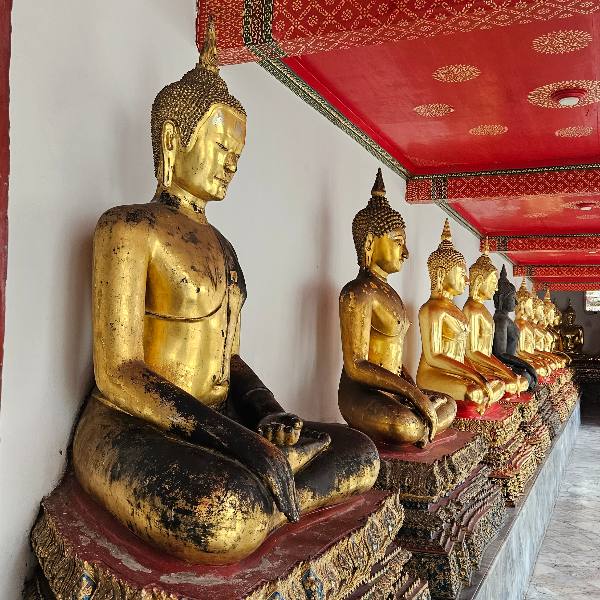
The temple complex houses over 1,000 Buddha images, making it a significant religious site for Buddhists. Wander the beautifully decorated pavilions and tranquil courtyards and take some time to look at the intricate murals that depict Buddhist teachings.
Immersing in the Serenity: What to Expect Inside Wat Pho
Once you step inside the heart of Wat Pho, it’s worth spending some time strolling around its courtyards. These are beautiful. I prefer this complex to the Grand Palace, as it’s quieter.
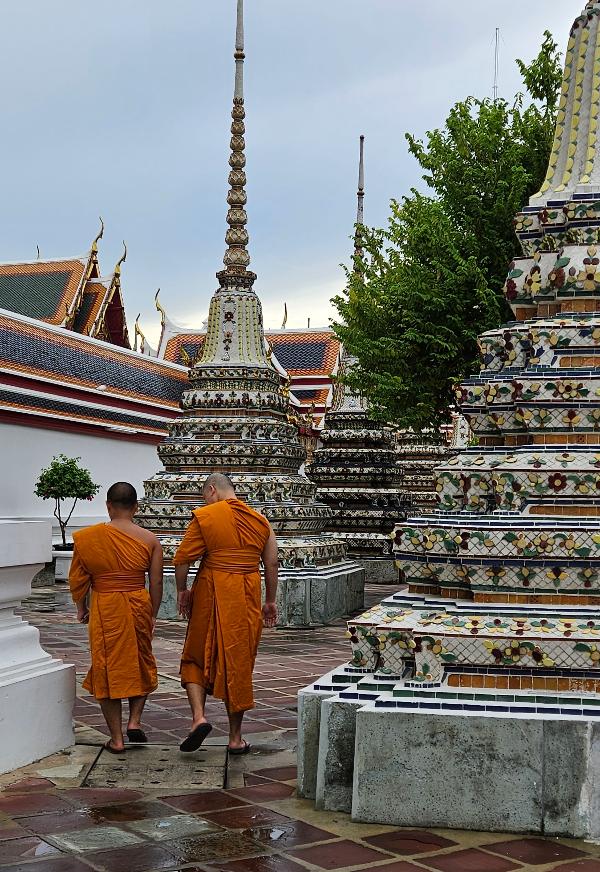
Nothing eclipses the temple’s central attraction: the 46m long and 15m tall statue of the Reclining Buddha. This image of Buddha during his last illness, encased in gold leaf, is humbling.
Don’t miss the mother-of-pearl inscriptions at the soles of the statue. These depict the 108 positive actions, called Lokshans, that helped Buddha achieve perfection.
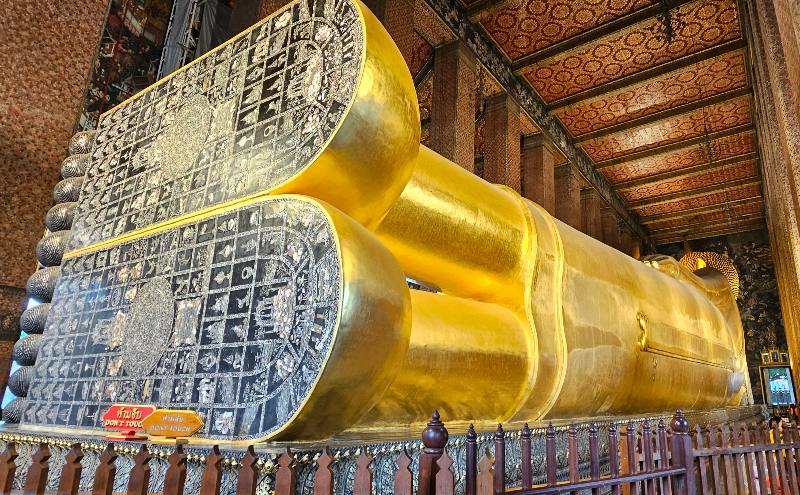
Wat Pho is also the birthplace of traditional Thai massage. If your legs are weary from temple-hopping, you can try a revitalising massage here for a reasonable fee.
The best time of day to visit Wat Pho
For our first visit, we arrived right on opening before the heat of the day kicked in. There were only three other people in the entire complex, making it perfect for enjoying quiet contemplation. We have also visited at dusk when the temple lights up, a perfect time to capture some stunning photos.
What to do near Wat Pho
- Pop into Museum Siam to learn more about Thai culture; it’s only two minutes away.
- Visit the nearby Flower Market, Pak Khlong Talat, for a burst of colour and culture.
- Grab a bargain-priced drink with a view at Poh Tha Tian which is right on the riverfront.
- Ride the Chao Phraya HOHO which stops at Rajinee Pier.
How to get to Wat Pho
Wat Pho is well-connected by various modes of public transportation, making it easy for first-time visitors.
Where: 2 Sanamchai Rd, Grand Palace Subdistrict, Pranakorn District
When: Daily from 8am-6.30pm
How: From Sathorn Central Pier, you can take the Chao Phraya Express Boat or an orange flag boat towards Tha Tien pier, this is currently closed for repairs so jump off at Rajinee which is the stop before. It’s next to the nearest MRT stop at Sanam Chai, an easy 8 minute walk away.
Wat Traimit: Temple of the Golden Buddha
Head to Yaowarat in Bangkok’s Chinatown, and you’ll discover Wat Traimit Withayaram Worawihan, the ‘Temple of the Golden Buddha’. This temple is home to the world’s largest gold seated Buddha – a remarkable 3 metres high and weighing around 5.5 tonne!
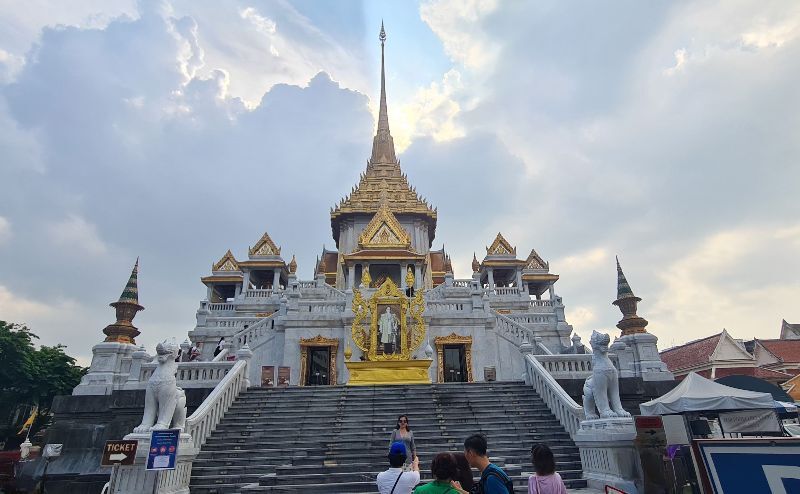
The secret of the Golden Buddha
Wat Traimit has an extraordinary history. The golden Buddha statue was cleverly concealed in plaster around the 15th century by the Ayutthaya Kingdom. This was a common method used to guard valuable treasures from invaders by masking them with less valuable materials.
The secret was only discovered when the image was accidentally dropped during relocation in 1955. The covering chipped off, unveiling the impressive, solid gold Buddha beneath.
Inside Wat Traimit
Inside the main building, you’ll find an exhibition detailing the statue’s fascinating history. If you can’t wait to see the golden statue up close, head straight up the stairs.
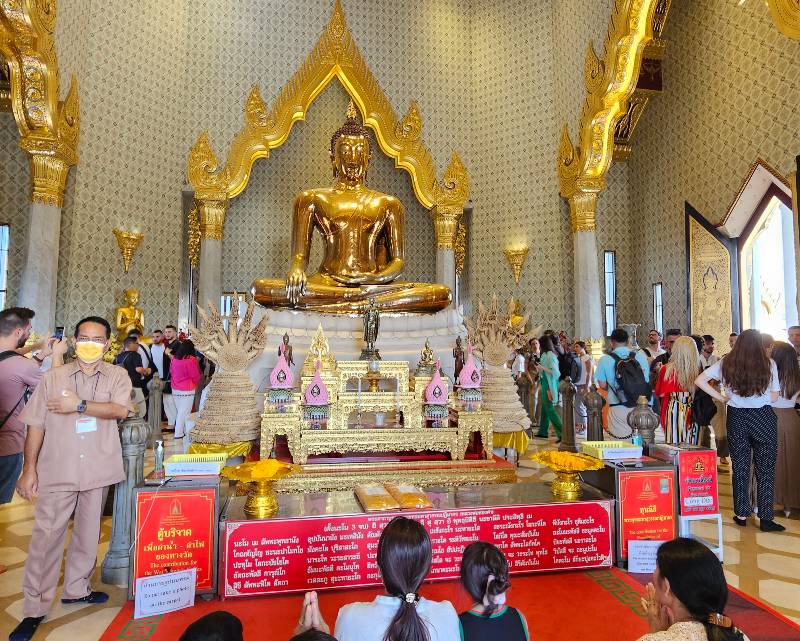
Step outside and take in the panoramic view from the top of Wat Traimit over the streets of Chinatown.
Tip: We think the best time to visit Wat Traimit is in the cool of the morning. Afternoons see large numbers of visitors who stop here before heading to Chinatown to eat.
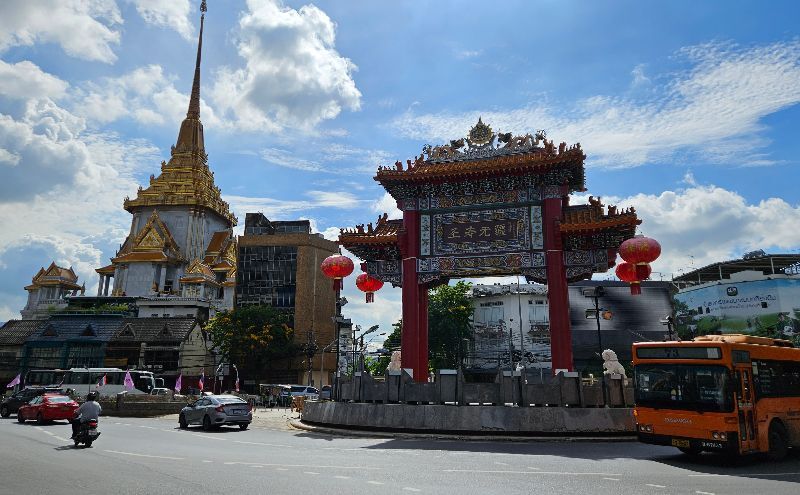
What to do near Wat Traimit
- Wander Talad Noi and explore some of the best street art in Bangkok.
- If you visit in the morning grab some pork porridge from Jae Hmoy Kia Pork Porridge.
- Pop into Mana Craft for excellent coffee and some great sourdough.
- Visit Over the Influence – a small contemporary art gallery across the road from the temple.
How to get to Wat
Where: Traimit Road, Khwaeng Talat Noi, Khet Samphanthawong.
When: Wat Traimit is open daily from 8am-5pm.
How: Take the BTS Skytrain to Hua Lamphong station, then it’s a short 10-minute walk to the temple. If you have a day pass for the “Chao Phraya Express Boat,” ride to “Ratchawong Pier” and walk about 1km mostly along Yaowarat Road, or get off at the Marine Department wharf for a 750m walk via Talat Noi.
Wat Saket: Golden Mount Temple
Wat Saket, also known as the Golden Mount Temple, stands at the heart of Bangkok. Its gleaming gold chedi, perched high on a man-made hill, makes it visible from afar and undeniably alluring.
The moment you step inside the gates, you’ll be greeted by a lush garden that feels like an oasis amidst the urban hustle.
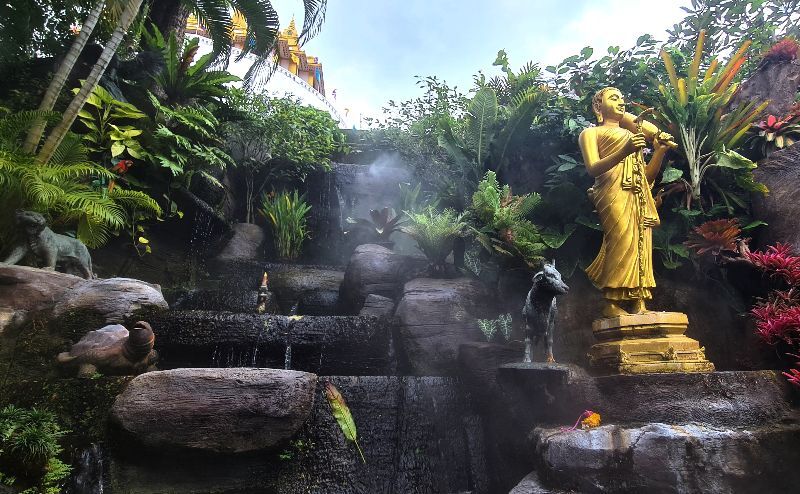
Make your way to the iconic red staircase. There are 344 steps between you and the magnificent golden chedi at the top. Don’t worry, the climb is gentle, and there are plenty of distractions along the way, including serene gardens, gongs to ring for good luck, and resting spots where you can catch your breath and admire the view.
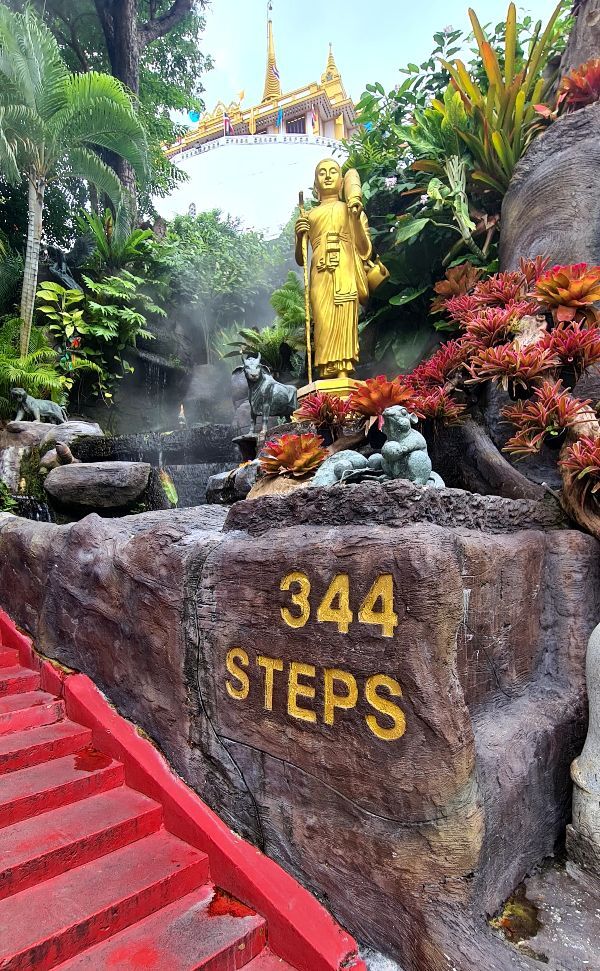
The chedi houses a sacred Buddha relic and stunning murals detailing Buddha’s teachings in the main temple. Once you reach the top, spend some time soaking in the panoramic views of old Bangkok—it’s one of the best temple views in the city.
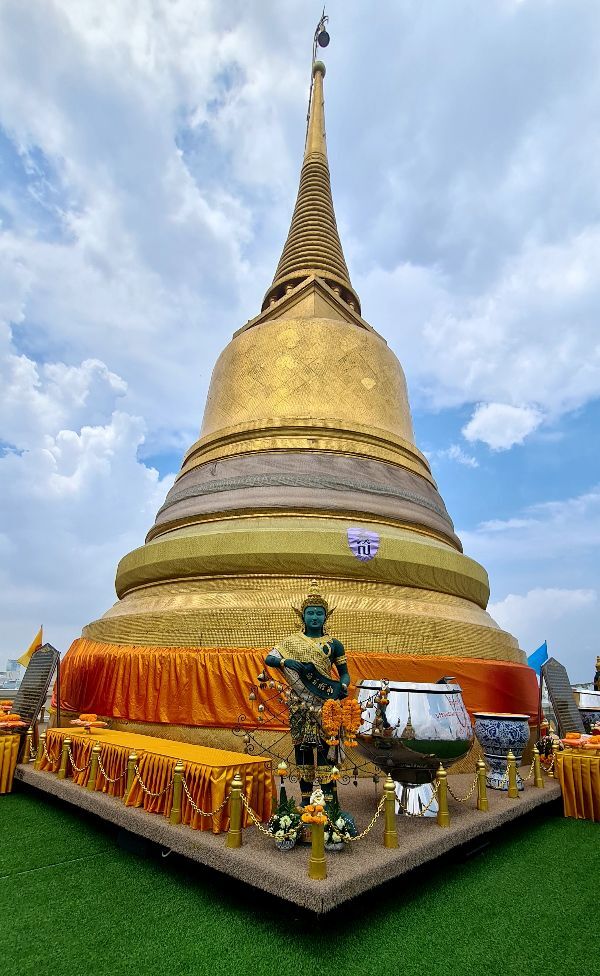
Tip: Expect crowds during the annual Loy Krathong festival, when thousands of people gather to pay their respects and release floating lanterns into the sky.
For a quieter experience, visit early in the morning or late in the afternoon to avoid the midday heat and crowds.For a quieter experience, visit early in the morning or late in the afternoon to avoid the midday heat and crowds.
What to do near Wat Saket
- Walk to Panfa Leelard Pier and ride the canal boats along Saen Saep. It’s a fun way to see another side of the city.
- Get in line at Raan Jay Fai for a meal cooked by Bangkok’s famous chef in goggles at this Michelin-starred street food spot.
- If the wait is too long, head to Tee Yen Ta Fo for some delicious pork leg and rice.
- Wander through this bustling wholesale clothing market, full of fresh fruit, vegetables, and halal food stalls.
How to get to Golden Mount Temple
Where: 344 Thanon Chakkraphat Phiphat, Khwaeng Ban Bat, Khet Pom Prap Sattru Phai.
When: Daily from 8am-7pm
How: You can take bus numbers 2, 47, 49, 59, 60, or 79, which stop within a 10-minute walk of the temple. Alternatively, the Saen Saep Khlong boat stops just a few minutes’ walk away.
Wat Arun: The Temple of Dawn
Wat Arun, also known as the Temple of Dawn, is one of Bangkok’s most iconic landmarks, majestically sitting on the banks of the Chao Phraya River. The temple’s name comes from the Hindu god Aruna, often represented as the sun’s radiance. Fitting as this temple is particularly stunning at sunrise and sunset, when its spires glow in the gentle light.
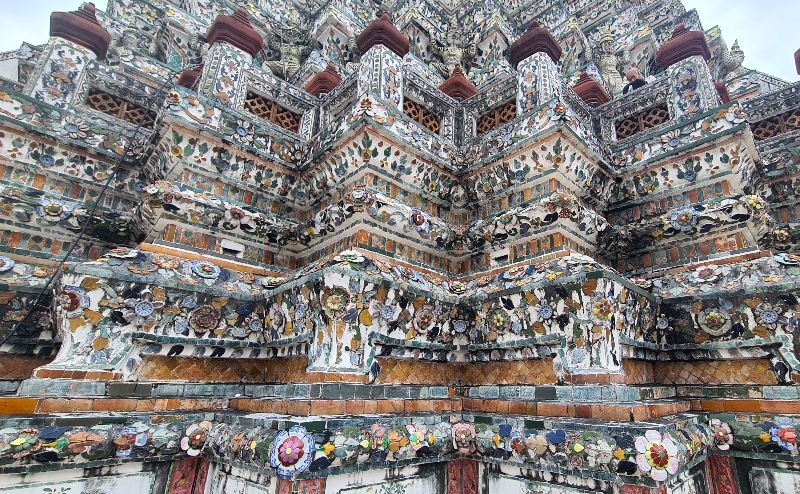
The temple’s central feature is its towering prang (spire), which stands at about 70 meters high and is adorned with intricate mosaics made from porcelain shards and seashells.
Climbing the steep steps of the prang offers a rewarding experience with stunning panoramic views over the river and the surrounding city.
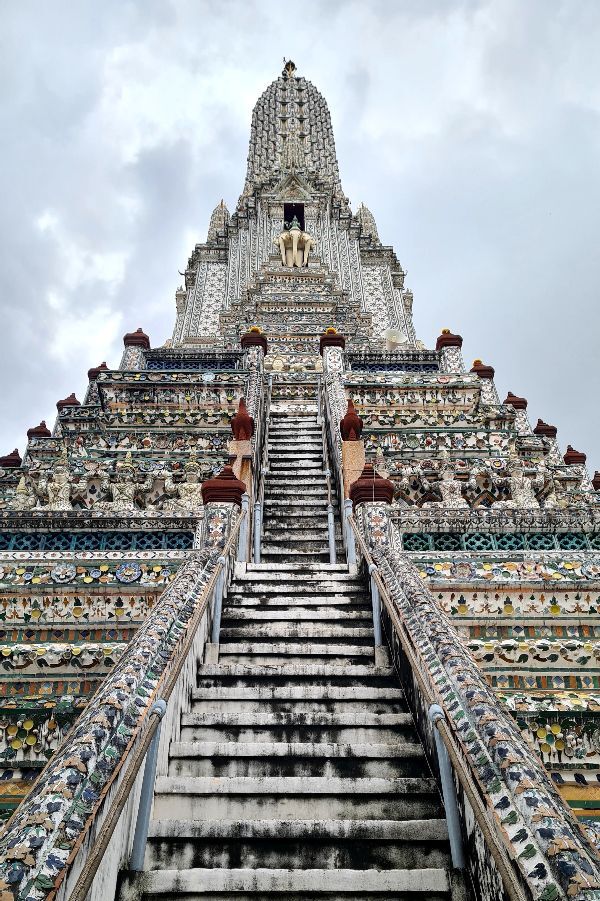
Beyond the main prang, Wat Arun’s grounds include a collection of smaller prangs, statues of mythical creatures, and beautifully landscaped gardens. You can also find an ordination hall with a golden Buddha image, adding to the temple’s spiritual allure.
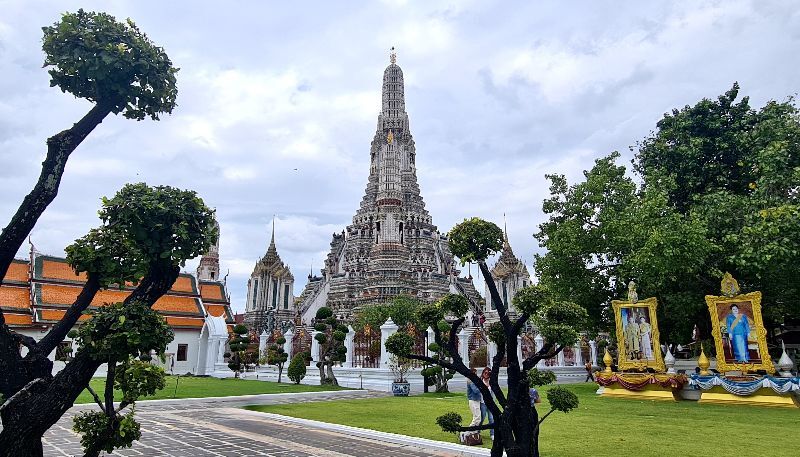
We recommend visiting Wat Arun either early in the morning or late in the afternoon. The golden hour at sunset is particularly magical, and you’ll get to see the temple’s silhouette beautifully reflected on the river’s surface.
What to do near Wat Arun
- Book a tour with Hidden Bangkok – Then visit the next temple, Wat Paknam, with them after you finish here. The meeting place is a 6-minute walk away.
- Order a bowl of chicken rice from Mui Lee Chicken and Rice.
- Jump back on the ferry or make your way by taxi or on foot (20 minutes) to this busy market. Open daily from 9am to 6pm, it’s a great place to try street food and pick up unique souvenirs.
How to get to Wat Arun
Where: 158 Wang Doem Road, Wat Arun Subdistrict, Bangkok Yai District,
When: 8.30am-5.30pm
How: Take the Chao Phraya Hop on hop off ferry to Wat Arun wharf where you will find the entry into the temple grounds. You can also take a ferry for 5 Baht from Tha Tian Wharf on the opposite side of the river.
Wat Paknam: The Big Gold Buddha
While the colossal Buddha statue draws most of us to Wat Paknam Phasi Charoen, this temple has a rich history dating back to 1610. The recent addition of the massive gold Buddha, completed in 2021, has significantly increased the temple’s appeal.
Standing 69 meters tall and 40 meters wide, it towers over Thonburi and indeed the Chao Phraya.
Made entirely of pure bronze, it’s one of the largest statues of its kind in the world and can be seen from various unexpected vantage points around the city, including the Tha Phra BTS Station.
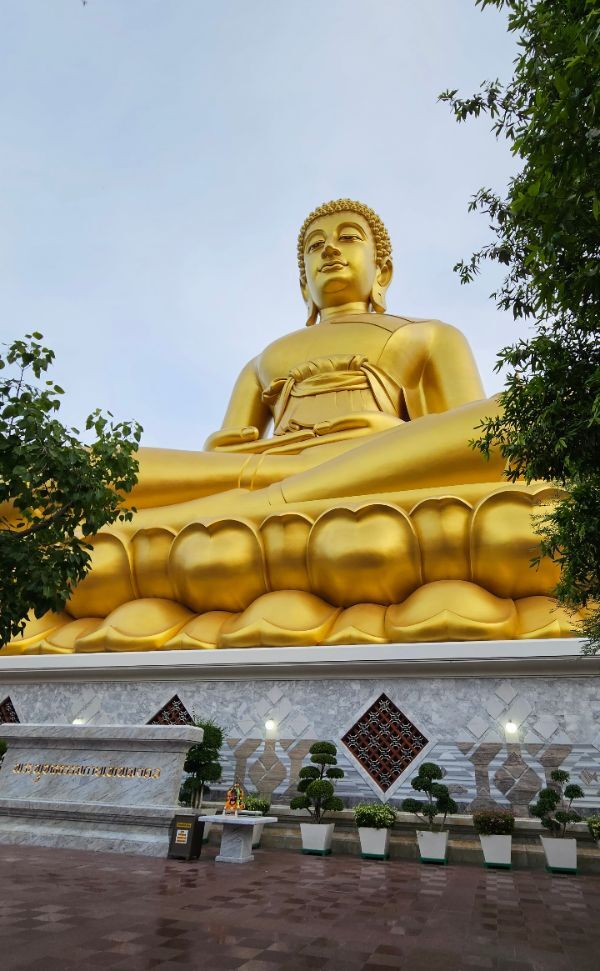
In addition to the awe-inspiring Buddha, Wat Paknam features an 80-meter-high, five-story white stupa that houses a museum of relics and donated items. I got a little carried away by the star of the show on my first visit and didn’t even look inside.
Don’t make my mistake, the fifth floor boasts a stunning painted ceiling and an impressive emerald stupa.There is a walkway that offers unique views of the gold Buddha and the surrounding area.
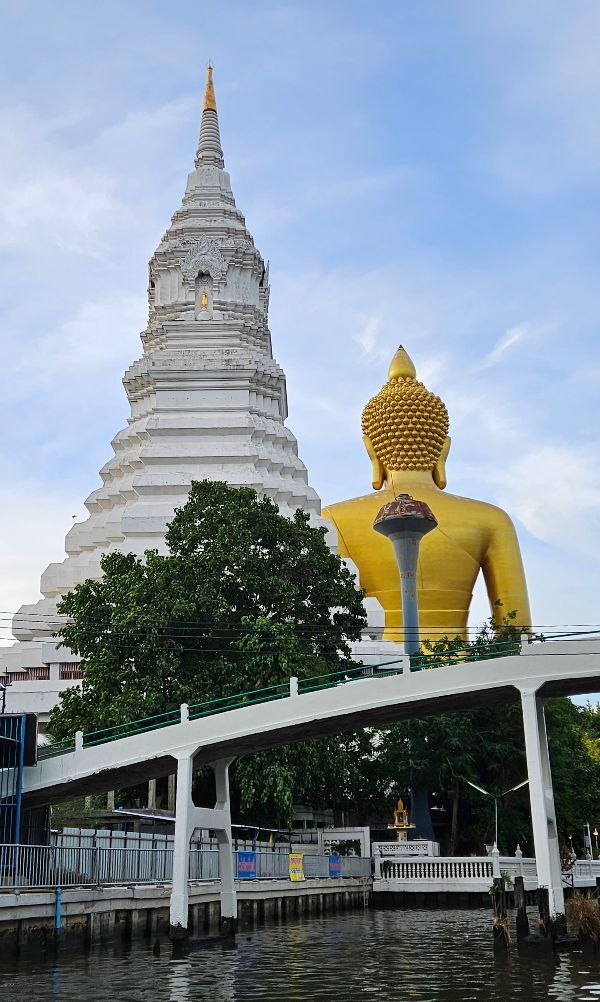
What to do near Wat Paknam
- Whether you arrive by long-tail boat or on foot, head to the Artist’s House. Once a market, it is now a vibrant arts and crafts area where you can purchase local works or even create your own masterpiece.
- If you feel like a hot or cold refreshment, head to Meili Cafe just across the canal and watch the world go by.
- Have a wander around nearby Talat Phlu Market and brave some street food you have not yet tried.
How to get to the Giant Buddha
Where: 300 Ratchamongkhon Prasat Alley, Pak Khlong Phasi Charoen, Phasi Charoen, Bangkok
When: 8am until 6pm
How: Wat Paknam can be a bit tricky to get to. One convenient option is to book a tour with Hidden Bangkok that includes a long-tail boat tour and a visit to the Artist’s House and the temple.
Alternatively, you can reach Wat Paknam by taking the MRT to Bang Phai, followed by a 12-minute (800m) walk. If you prefer not to walk, the BTS Station at Watthukat is closer, and there are usually plenty of taxis waiting to pick up temple visitors.
Book a private tour that covers the first 4 temples on our list in one day
Bangkok Temple Map
Navigating the Crowds: Best Times to Visit
I am a big fan of early morning temple visits. The weather is usually milder, there are few visitors about and you will not run into a single tour bus at 8am.
While mornings are ideal for quieter visits, there’s something magical about visiting certain temples in the late afternoon. The golden hour, just before sunset, casts a beautiful light on the temples, making them look especially enchanting.
Wat Arun and Wat Paknam are particularly stunning at sunset, providing excellent photo opportunities and a tranquil ambiance as the day winds down
If your schedule allows, plan your temple visits on weekdays. Weekends tend to attract more locals on their days off, so you’ll find the sites significantly busier
Respecting Culture: Dos and Don’ts of Visiting Temples
Do
- Dress Modestly: Wear clothing that covers your shoulders, knees, and everything in between. Loose, light fabrics are ideal for both cultural respect and comfort in the heat.
- Remove Your Shoes: Shoes that you can slip on and off quickly are handy. However, if you are like me and need better support on a big day of walking, it’s worth it to tie and untie your laces several times.
- Keep Your Voice Low: Please remember to be respectful as you visit the sacred spaces of Bangkok’s temples.
- Be Mindful of Your Feet: In Thai culture, pointing your feet towards a Buddha image is considered disrespectful. Sit cross-legged or kneel instead.
Don’t
- No Flash Photography: While taking photos is generally allowed, don’t use flash inside the temples as it can be disruptive.
- Respect Buddha Images: Do not climb on, touch, or sit on Buddha statues. Taking selfies with Buddha images is often prohibited and considered disrespectful.
- Avoid Public Displays of Affection: Temples are places of worship, so it’s important to avoid hugging, kissing, or any other public displays of affection.
Making an offering
- Offerings to Monks: If you wish to make an offering, place it in the designated area or hand it to a layperson assisting the monk. Women should never touch a monk or give anything directly to him. Instead, place the offering down and allow the monk to pick it up.
Exploring Bangkok’s temples at your own pace allows you to truly appreciate their beauty and significance. Enjoy the journey, savor each moment, and let these sacred sites enrich your experience. Happy temple touring!
Planning a Thai adventure? Join our friendly Facebook community Thailand Awaits: Trip Planning for Beginners. Get expert advice from locals and experienced travellers, ask your questions, and discover how to make the most of your journey through Thailand.

About the author: Paula Morgan first visited Thailand in 1999 and has been returning regularly ever since. She loves exploring its less visited spots, not just the iconic landmarks and historic temples, but the family run cafes and food stalls and the small communities in the islands of the south and the lush forests and mountains of Thailand’s north.
